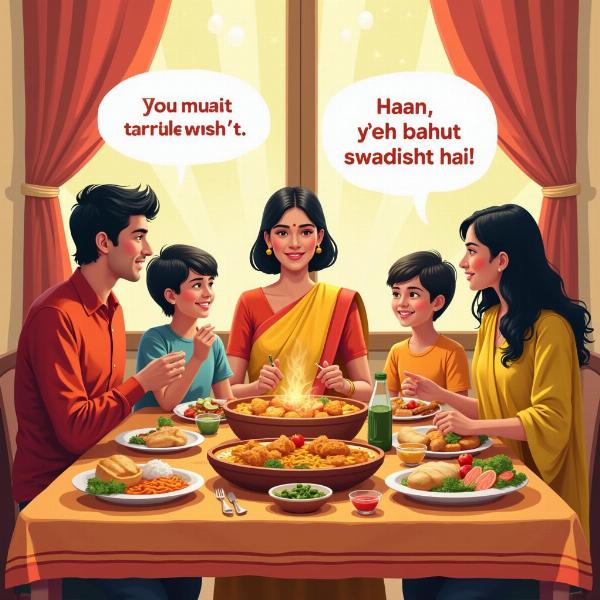Understanding the nuances of expressing liking in Hindi can enrich your communication and cultural understanding. While a simple “yes I like it” conveys the basic sentiment, exploring its various Hindi translations reveals a deeper appreciation for the language and its cultural context. This guide will delve into the various ways to express “yes I like it” in Hindi, considering different levels of formality, regional variations, and cultural implications.
Expressing “Yes I Like It” in Hindi
The most common and straightforward translation of “yes I like it” in Hindi is “हाँ, मुझे पसंद है” (haan, mujhe pasand hai). This phrase is versatile and suitable for most situations. “Haan” signifies “yes,” “mujhe” means “to me,” and “pasand” translates to “like.” Combining these words creates a clear and concise expression of liking something. However, Hindi offers a richer vocabulary to convey this sentiment with varying degrees of enthusiasm and formality.
Formal vs. Informal Expressions
While “haan, mujhe pasand hai” works well in most settings, you can opt for more formal or informal expressions depending on the context. For instance, “जी हाँ, मुझे अच्छा लगता है” (jee haan, mujhe achha lagta hai) adds a touch of formality with the inclusion of “jee,” a respectful particle. “Achha lagta hai” also implies “it feels good,” adding a subtle nuance to the expression. On the other hand, “हाँ, मुझे बहुत पसंद है!” (haan, mujhe bahut pasand hai!) expresses stronger enthusiasm by adding “bahut,” meaning “very.” You could also use “मुझे यह अच्छा लगा” (mujhe yeh achha laga) which translates to “I liked this” and is more suitable for past experiences.
Regional Variations
Like any language, Hindi has regional dialects that influence word choice and pronunciation. While the core meaning remains consistent, certain variations exist. For example, in some regions, “मुझे यह भाता है” (mujhe yeh bhata hai) is a common alternative, with “bhata hai” signifying “I like it.” Being aware of these regional nuances can enhance your understanding and communication with native speakers from different parts of India.
Beyond the Basics: Expressing Degrees of Liking
Hindi allows for a wider range of expression beyond a simple “like.” You can express stronger affection, admiration, or even love using words like “प्यार” (pyaar – love), “इഷ्ट” (isht – fondness), or “चाहना” (chahna – to want). For instance, “मुझे तुमसे प्यार है” (mujhe tumse pyaar hai) signifies “I love you,” while “मुझे यह बहुत इष्ट है” (mujhe yeh bahut isht hai) conveys a deep fondness for something. Understanding these nuances allows for more precise and expressive communication.
Responding to Compliments
When someone compliments you, a simple “धन्यवाद” (dhanyavaad – thank you) is appropriate. However, you can also add phrases like “आपकी प्रशंसा के लिए धन्यवाद” (aapki prashansa ke liye dhanyavaad – thank you for your compliment) to express your gratitude more explicitly.
“Yes I Like It” in Different Contexts
The meaning and usage of “yes I like it” can vary depending on the context. For example, in a shopping scenario, you might say “हाँ, यह मुझे पसंद है, मैं इसे ले लूँगा” (haan, yeh mujhe pasand hai, main ise le loonga – Yes, I like it, I’ll take it). In a restaurant, you could express your satisfaction with the food by saying “हाँ, यह बहुत स्वादिष्ट है” (haan, yeh bahut swadisht hai – Yes, this is very delicious).
How do you say “yes I like it very much” in Hindi?
You can express “yes I like it very much” in Hindi by saying “हाँ, मुझे यह बहुत पसंद है” (haan, mujhe yeh bahut pasand hai).
Is there a formal way to say “yes I like it” in Hindi?
Yes, “जी हाँ, मुझे अच्छा लगता है” (jee haan, mujhe achha lagta hai) is a more formal way to express liking in Hindi.
What are some other ways to express liking in Hindi?
Besides “pasand,” you can use words like “achha lagna,” “bhata hai,” “isht,” and “pyaar” to convey different degrees of liking and affection.
 Enjoying Indian Food
Enjoying Indian Food
Conclusion: Mastering the Nuances of Liking in Hindi
Learning to express “yes I like it” and its variations in Hindi goes beyond simple translation. It opens a window into the rich tapestry of Indian culture and communication. By understanding the different levels of formality, regional variations, and the broader spectrum of expressing affection and admiration, you can enhance your interactions and build stronger connections with Hindi speakers. So, embrace the diverse expressions of liking in Hindi and enrich your linguistic journey.
FAQ
- How do I say “I love it” in Hindi? You can say “मुझे यह बहुत पसंद है” (mujhe yeh bahut pasand hai) or “मुझे इससे प्यार है” (mujhe isse pyaar hai).
- What’s the difference between “pasand” and “achha lagna”? While both express liking, “pasand” is more general, while “achha lagna” implies a feeling of goodness or pleasantness.
- Can I use “haan, mujhe pasand hai” in all situations? Yes, it’s generally acceptable in most contexts.
- How do I respond to a compliment in Hindi? “धन्यवाद” (dhanyavaad – thank you) is a standard response.
- Are there any regional variations for “yes I like it” in Hindi? Yes, words like “bhata hai” are used in some regions.
Meaning-Hindi.in is your trusted partner for professional Hindi translation services. We offer a comprehensive range of services, from business and legal document translation to website localization and technical translation. Our expert linguists ensure accurate and culturally sensitive translations to meet your specific needs. Contact us today for all your Hindi translation requirements at [email protected] or call us at +91 11-4502-7584. Meaning-Hindi.in is dedicated to bridging the language gap and facilitating seamless communication.